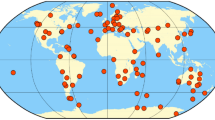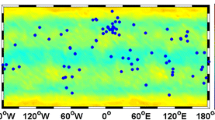Abstract
The focus of this study is on proper modeling of the dynamics for inter-system biases (ISBs) in multi-constellation Global Navigation Satellite System (GNSS) precise point positioning (PPP) processing. First, the theoretical derivation demonstrates that the ISBs originate from not only the receiver-dependent hardware delay differences among different GNSSs but also the receiver-independent time differences caused by the different clock datum constraints among different GNSS satellite clock products. Afterward, a comprehensive evaluation of the influence of ISB stochastic modeling on undifferenced and uncombined PPP performance is conducted, i.e., random constant, random walk process, and white noise process are considered. We use data based on a 1-month period (September 2017) Multi-GNSS Experiment (MGEX) precise orbit and clock products from four analysis centers (CODE, GFZ, CNES, and WHU) and 160 MGEX tracking stations. The results demonstrate that generally, the positioning performance of PPP in terms of convergence time and positioning accuracy with the final products from CODE, CNES, and WHU is comparable among the three ISB handling schemes. However, estimating ISBs as random walk process or white noise process outperforms that as the random constant when using the GFZ products. These results indicate that the traditional estimation of ISBs as the random constant may not always be reasonable in multi-GNSS PPP processing. To achieve more reliable positioning results, it is highly recommended to consider the ISBs as random walk process or white noise process in multi-GNSS PPP processing.








Similar content being viewed by others
References
Bock H, Dach R, Jaggi A, Beutler G (2009) High-rate GPS clock corrections from CODE: support of 1 Hz applications. J Geod 83(11):1083–1094
Chen J, Zhang Y, Wang J, Yang S, Dong D, Wang J, Qu W, Wu B (2015) A simplified and unified model of multi-GNSS precise point positioning. Adv Space Res 55(1):125–134
de Bakker PF, Tiberius CCJM (2017) Real-time multi-GNSS single-frequency precise point positioning. GPS Solut 21(4):1791–1803
Gao W, Meng X, Gao C, Pan S, Wang D (2018) Combined GPS and BDS for single-frequency continuous RTK positioning through real-time estimation of differential inter-system biases. GPS Solut 22:20. https://doi.org/10.1007/s10291-017-0687-5
Geng J, Bock Y (2016) GLONASS fractional-cycle bias estimation across inhomogeneous receivers for PPP ambiguity resolution. J Geod 90(4):379–396
Guo F, Zhang X, Wang J, Ren X (2016a) Modeling and assessment of triple-frequency BDS precise point positioning. J Geod 90(11):1223–1235
Guo J, Xu X, Zhao Q, Liu J (2016b) Precise orbit determination for quad-constellation satellites at Wuhan University: strategy, result validation and comparison. J Geod 90(2):143–159
Guo F, Li X, Zhang X, Wang J (2017) Assessment of precise orbit and clock products for Galileo, BeiDou, and QZSS from IGS Multi-GNSS Experiment (MGEX). GPS Solut 21(1):279–290
Guo J, Li X, Li Z, Hu L, Yang G, Zhao C, Fairbairn D, Watson D, Ge M (2018) Multi-GNSS precise point positioning for precision agriculture. Precis Agric 19(5):895–911
Han S, Kwon J, Jekeli C (2001) Accurate absolute GPS positioning through satellite clock offset error estimation. J Geod 75(1):33–43
Jiang N, Xu Y, Xu T, Xu G, Sun Z, Schuh H (2017) GPS/BDS short-term ISB modelling and prediction. GPS Solut 21(1):163–175
Khodabandeh A, Teunissen PJG (2016) PPP-RTK and inter-system biases: the ISB look-up table as a means to support multi-system PPP-RTK. J Geod 90(9):837–851
Kouba J (2015) A guide to using international GNSS service (IGS) products, September 2015 update. http://kb.igs.org/hc/en-us/articles/201271873-A-Guide-to-Using-the-IGS-Products. Accessed 30 Mar 2019
Kouba J, Héroux P (2001) Precise point positioning using IGS orbit and clock products. GPS Solut 5(2):12–28
Leick A, Rapoport L, Tatarnikov D (2015) GPS satellite surveying, 4th edn. Wiley, Hoboken
Li P, Zhang X (2014) Integrating GPS and GLONASS to accelerate convergence and initialization times of precise point positioning. GPS Solut 18(3):461–471
Li X, Ge M, Dai X, Ren X, Fritsche M, Wickert J, Schuh H (2015) Accuracy and reliability of multi-GNSS real-time precise positioning: GPS, GLONASS, BeiDou, and Galileo. J Geod 89(6):607–635
Li P, Zhang X, Guo F (2017) Ambiguity resolved precise point positioning with GPS and BeiDou. J Geod 91(1):25–40
Li P, Zhang X, Ge M, Schuh H (2018) Three-frequency BDS precise point positioning ambiguity resolution based on raw observables. J Geod 92(12):1357–1369
Liu J, Ge M (2003) PANDA software and its preliminary result of positioning and orbit determination. Wuhan Univ J Nat Sci 8(2B):603–609
Liu T, Yuan Y, Zhang B, Wang N, Tan B, Chen Y (2017) Multi-GNSS precise point positioning (MGPPP) using raw observations. J Geod 91(3):253–268
Lou Y, Zheng F, Gu S, Wang C, Guo H, Feng Y (2016) Multi-GNSS precise point positioning with raw single-frequency and dual-frequency measurement models. GPS Solut 20(4):849–862
Lu C, Li X, Cheng J, Dick G, Ge M, Wickert J, Schuh H (2018) Real-time tropospheric delay retrieval from multi-GNSS PPP ambiguity resolution: validation with final troposphere products and a numerical weather model. Remote Sens 10(3):481. https://doi.org/10.3390/rs10030481
Montenbruck O, Steigenberger P, Prange L, Deng Z, Zhao Q, Perosanz F, Romero I, Noll C, Stürze A, Weber G, Schmid R, Macleod K, Schaer S (2017) The multi-GNSS experiment (MGEX) of the international GNSS service (IGS)—achievements, prospects and challenges. Adv Space Res 59(7):1671–1697
Odijk D, Teunissen PJG (2013) Characterization of between-receiver GPS-Galileo inter-system biases and their effect on mixed ambiguity resolution. GPS Solut 17(4):521–533
Odijk D, Zhang B, Khodabandeh A, Odolinski R, Teunissen PJG (2016) On the estimability of parameters in undifferenced, uncombined GNSS network and PPP-RTK user models by means of S-system theory. J Geod 90(1):15–44
Prange L, Orliac E, Dach R, Arnold D, Beutler G, Schaer S, Jäggi A (2017) CODE’s five-system orbit and clock solution—the challenges of multi-GNSS data analysis. J Geod 91(4):345–360
Rebischung P, Schmid R (2016) IGS14/igs14.atx: a new framework for the IGS products. AGU Fall Meeting, San Francisco, CA
Steigenberger P, Hugentobler U, Hauschild A, Montenbruck O (2013) Orbit and clock analysis of Compass GEO and IGSO satellites. J Geod 87(6):515–525
Wanninger L, Beer S (2015) BeiDou satellite-induced code pseudorange variations: diagnosis and therapy. GPS Solut 19(4):639–648
Wessel P, Smith WHF, Scharroo R, Luis J, Wobbe F (2013) Generic mapping tools: improved version released. EOS Trans AGU 94(45):409–410
Xiang Y, Gao Y, Shi J, Xu C (2017) Carrier phase-based ionospheric observables using PPP models. Geod Geodyn 8(1):17–23
Zeng A, Yang Y, Ming F, Jing Y (2017) BDS–GPS inter-system bias of code observation and its preliminary analysis. GPS Solut 21(4):1573–1581
Zhou F, Dong D, Ge M, Li P, Wickert J, Schuh H (2018a) Simultaneous estimation of GLONASS pseudorange inter-frequency biases in precise point positioning using undifferenced and uncombined observations. GPS Solut 22:19. https://doi.org/10.1007/s10291-017-0685-7
Zhou F, Dong D, Li W, Jiang X, Wickert J, Schuh H (2018b) GAMP: an open-source software of multi-GNSS precise point positioning using undifferenced and uncombined observations. GPS Solut 22:33. https://doi.org/10.1007/s10291-018-0699-9
Acknowledgements
We would like to thank the IGS Multi-GNSS Experiment (MGEX) for providing multi-GNSS ground tracking data, DCBs, precise orbit and clock products. The figures were generated using the public domain GMT software (Wessel et al. 2013). This work is sponsored by the Scientific Research Foundation of Shandong University of Science and Technology for Recruited Talents (No. 2017RCJJ074) and the National Natural Science Foundation of China (No. 41771475).
Author information
Authors and Affiliations
Corresponding author
Additional information
Publisher's Note
Springer Nature remains neutral with regard to jurisdictional claims in published maps and institutional affiliations.
Rights and permissions
About this article
Cite this article
Zhou, F., Dong, D., Li, P. et al. Influence of stochastic modeling for inter-system biases on multi-GNSS undifferenced and uncombined precise point positioning. GPS Solut 23, 59 (2019). https://doi.org/10.1007/s10291-019-0852-0
Received:
Accepted:
Published:
DOI: https://doi.org/10.1007/s10291-019-0852-0




